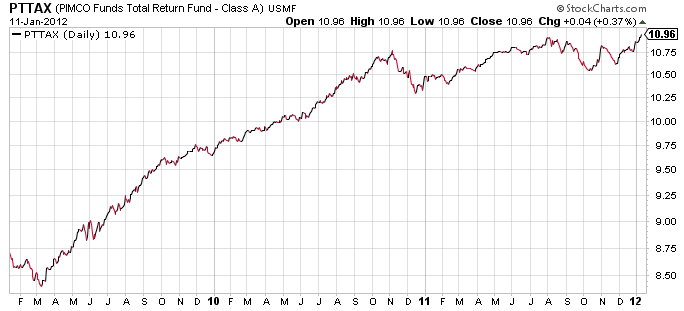Pimco Total Return ETF A Big Idea In A Small Package
Post on: 8 Апрель, 2015 No Comment

Pimco Total Return ETF: A Big Idea In A Small Package
February 8, 2013 Tom Lydon
During its first couple months of trading, Pimco Total Return Bond ETF (BOND) showed that good things do indeed come in small packages, as the nimble portfolio allowed Bill Gross, co-chief investment officer at Pacific Investment Management Co. to outperform the famous mutual fund he also oversees.
The actively managed ETF has ballooned to over $4 billion in less than a year, but we dont expect the fund to become a victim of its own success and size.
BOND is known as the ETF version of the famous Pimco Total Return Mutual Fund (PTTRX)both are managed by the bond guruexcept that BOND is required to disclose its portfolio holdings on a daily basis as an active ETF. The ETF version has also been outperforming the flagship fund, gaining 11.75 percent since its inception on February 29, 2012, through February 4, 2013, compared to the 7.6% gain in PTTRX over the same period.
Over that time, some have pointed to two factors that helped BOND outperform its predecessor: the lack of derivatives and legacy positions.
Previously, there was a moratorium on the use of derivatives in new ETFs. As such, BOND was launched without the use of derivative securities to gain exposure to bonds. Consequently, this put the two fund versions on opposite sides of the spectrum regarding portfolio make-up and total number of holdings. BOND would directly hold bonds and currently holds around 771 components, whereas PPTRX receives various bond exposures through swap agreements and can hold upwards of 19,000 components.
While swaps allow the fund to efficiently tap a segment of the bond market, the swap agreements can limit a managers ability to pick out individual credits since swaps are based on a broader index. As a result, re-allocating assets becomes expensive and risky for the portfolio manager, and can have a negative impact upon the market.
However, the Securities and Exchange Commission lifted its restrictions on active ETFs derivatives use in early December 2012. Pimco, in a filing last year, stated that it would use derivatives in the ETF if the SEC should lift the ban.
Additionally, BOND was created with $10 million in assets under management, and Gross was able to begin with a clean slate without legacy positions. The past years outperformance in the BOND ETF illustrates how a highly skilled manager can add value in a relatively small portfolio.
When BOND first launched, Gross said it was much different than managing the huge Pimco Total Return Fund due to the flexibility of running a small ETF. It was like a young deer able to bounce quickly through the forest, he recently said at the 2013 ETF Virtual Summit.
A Closer Look At BOND
The Pimco Total Return ETF, like the flagship fund, holds exposure to a basket of fixed-income assets. The ETF has an effective duration of 4.83 years. The effective duration is a measure of a securitys price sensitivity to change in interest rates, and a lower effective duration would translate to a smaller hit in the principal if interest rates were to rise. The ETF comes with a 1.62% 30-day SEC yield and a 0.55% expense ratio.
As of the end of 2012, BOND holdings include government Treasuries (16 percent), government agencies (2 percent), mortgage debt (37 percent), investment grade credit (6 percent), high-yield credit (4 percent), non-U.S. developed (11 percent), emerging markets (1 percent), municipals (10 percent), money market/cash (9 percent) and (4 percent) in others, such as convertibles and preferreds.
Gross has mentioned that the ETF is free to overweight certain fixed-income sectors, such as Treasury Inflation Protected Securities (TIPS) and municipal debt, as well as international bonds in countries with economies growing faster than the U.S. that are less leveraged.
Country exposure includes U.S. (89.9 percent), Mexico (7.4 percent), U.K. (5.9 percent), Italy (4.5 percent), Spain (3.4 percent), Norway (2.0 percent), France (1.7 percent), Japan (0.9 percent), Canada (0.8 percent), Brazil (0.6 percent), Netherlands (0.4 percent), Ireland (0.3 percent), South Korea (0.3 percent), Luxembourg (0.1 percent) and Cayman Islands (0.1 percent).
Gross Warns Of Consequences To Loose Monetary Policies
At the ETF Virtual Summit, Gross stated that quantitative easing from the Federal Reserve and other central banks along with extremely low interest rates have provided an artificial lift to bonds. As a result, most markets are bubbled.
Nevertheless, Gross said he doesnt see a major bubble like the dot-com craze or U.S. housing market that will dramatically pop, because central bank policies will continue.
But risk assets dont produce what they used to produce, Gross said. At these levels he says there is risk in terms of higher bond yields and lower price-to-earnings ratios for stocks. While, the BOND manager was not forecasting a recession, he did anticipate slower economic growth.
Meanwhile, zero-bond interest rates are having an increasingly negative effect on certain business models, such as banks and insurers, and pension funds are having a hard time meeting obligations, Gross said. To keep interest rates low in the U.S. the Federal Reserve is writing about $1 trillion in checks a year, which buys 80% of Treasuries.
Consequently, Gross advised investors to be careful with long-term bonds that could get hurt if inflation picks up after 2013.














